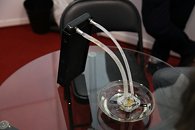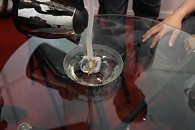- Joined
- Oct 9, 2007
- Messages
- 47,885 (7.38/day)
- Location
- Dublin, Ireland
| System Name | RBMK-1000 |
|---|---|
| Processor | AMD Ryzen 7 5700G |
| Motherboard | Gigabyte B550 AORUS Elite V2 |
| Cooling | DeepCool Gammax L240 V2 |
| Memory | 2x 16GB DDR4-3200 |
| Video Card(s) | Galax RTX 4070 Ti EX |
| Storage | Samsung 990 1TB |
| Display(s) | BenQ 1440p 60 Hz 27-inch |
| Case | Corsair Carbide 100R |
| Audio Device(s) | ASUS SupremeFX S1220A |
| Power Supply | Cooler Master MWE Gold 650W |
| Mouse | ASUS ROG Strix Impact |
| Keyboard | Gamdias Hermes E2 |
| Software | Windows 11 Pro |
Raijintek unveiled its first liquid cooler that works without a prime-mover for the coolant (i.e. no pump). Further, its radiator lacks fans (i.e. no power, no noise). This closed-loop cooler works in the same principle as a heat pipe, with a combination of convention and phase-change doing the heavy lifting of heat-transfer. Heat from the source (your CPU) causes the special coolant to change phase to vapor, move to the heat-exchanger (radiator), where it condenses back to liquid, and flows back down to the block. We saw this contraption in action, and we can tell you that it works. It is ready for the real-world. Raijintek spent vast amounts of R&D budget developing this technology, and has patented it in most markets. We could see the first products based on this technology very soon.



View at TechPowerUp Main Site



View at TechPowerUp Main Site





 , an AIO liquid cooler that can't have pump issues. I may go back to a AIO if this is good enough to cool a OC'ed chip running full load for weeks on end.
, an AIO liquid cooler that can't have pump issues. I may go back to a AIO if this is good enough to cool a OC'ed chip running full load for weeks on end.